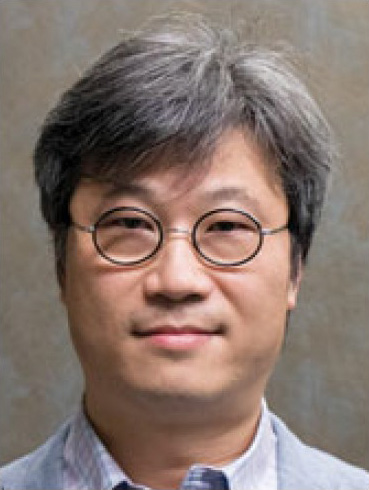题目:When mechanics meets chemistry – novel nickel-hydroxide/oxyhydroxide thin-film actuating material that can be triggered by both light and electricity
报告人:Prof. Alfonso H.W. Ngan
时间:6月25日(周一)上午10:00-12:00
地点:李薰楼468室
When mechanics meets chemistry – novel nickel-hydroxide/oxyhydroxide thin-film actuating material that can be triggered by both light and electricity
A.H.W. Ngan (颜庆云)
Department of Mechanical Engineering, University of Hong Kong, Hong Kong, P.R. China
Here we report a novel actuating material – nickel hydroxide-oxyhydroxide – that exhibits enormous actuation due to a volume change stimulated either electrochemically, or by illumination of visible light of low intensities. For electrochemical actuation, Ni(OH)2/NiOOH is capable of undergoing fast, reversible, and large actuation in alkaline electrolytes under potentials of less than 1 V, due to a redox reaction involving volume changes. On the other hand, the light actuation of Ni(OH)2/NiOOH is due to its turbostratic crystal structure which is capable of intercalating water molecules. It is shown that the intercalated water can be rapidly and reversibly desorbed into the environment under visible light of low intensities, resulting in fast actuation driven wirelessly by light.
By electroplating the actuating material on passive substrates, we have fabricated film-actuators capable of undergoing reversible bending and curling with an intrinsic actuating stress of tens of megapascals at response rates in the order of tens to hundreds of degrees per second, which are comparable to mammalian skeletal muscles. Also, by intentionally electroplating the nickel hydroxide-oxyhydroxide on selected areas of the substrate, we have also fabricated actuation devices of varies shapes and functions, e.g. a hinged actuator that can lift objects ~100 times of the weight of the actuating material is achieved, and other examples showing the potential use in robotic devices. The light-induced actuation mechanism reported here has the potential for realizing wirelessly powered micro-robotic devices.
Related publications:
[1] K.W. Kwan, S.J. Li, N.Y. Hau, W.D. Li, S.P. Feng and A.H.W. Ngan, (2018), “Light-stimulated actuators based on nickel hydroxide-oxyhydroxide”, Science Robotics 3, eaat4051 (DOI: 10.1126/scirobotics.aat4051).
[2] K.W. Kwan, N.Y. Hau, S.P. Feng and A.H.W. Ngan, (2017), “Electrochemical actuation of nickel hydroxide/oxyhydroxide at sub-volt voltages”, Sensors and Actuators B: Chemical 248, 657-664.
Information of Prof. Alfonso H.W. Ngan (颜庆云教授)
 Professor Alfonso H.W. Ngan is currently Kingboard Professor in Materials Engineering, Chair Professor of Materials Science and Engineering, as well as Head of Department of Mechanical Engineering, at the University of Hong Kong. He obtained his BSc (Eng) degree from the University of Hong Kong in 1989, and PhD from the University of Birmingham in the U.K. in 1992. After a year of postdoctoral training at Oxford University, he joined HKU in 1993, and was promoted through the ranks to Chair Professorship in 2011.
Professor Alfonso H.W. Ngan is currently Kingboard Professor in Materials Engineering, Chair Professor of Materials Science and Engineering, as well as Head of Department of Mechanical Engineering, at the University of Hong Kong. He obtained his BSc (Eng) degree from the University of Hong Kong in 1989, and PhD from the University of Birmingham in the U.K. in 1992. After a year of postdoctoral training at Oxford University, he joined HKU in 1993, and was promoted through the ranks to Chair Professorship in 2011.
Professor Ngan is a leading authority in the microstructural basis of properties of engineering materials, in particular, crystalline defects and their modeling, and nanomechanics including applications to biological systems. He has published over 200 ISI papers, and co-authored two books. His main contributions include a method, the so-called “Feng-Ngan equation”, for correcting viscoelastic effects in nanoindentation measurements of soft materials, which has been used by peer researchers in their work as reported in more than 100 ISI publications by now. His research-related honours include the prestigious Rosenhain Medal and Prize from the Institute of Materials, Minerals and Mining, U.K., in 2007 – he is the only non-British national so far to have received this award since its establishment in 1951. He was also awarded a higher doctorate (DSc) from his alma mater the University of Birmingham in 2008, the Croucher Senior Research Fellowship in 2009, and in 2014 he was elected to the Hong Kong Academy of Engineering Sciences. He is a well sought-after journal reviewer, winning the Outstanding Reviewer Award of Scripta Materialia five times, in 2006, 2008, 2011, 2015 and 2016. He has organized a number of key conferences, including Dislocations 2008 and Gordon Research Conference on Nanomechanical Interfaces in 2013, both held in Hong Kong. He is serving on the Gordon Research Conference Board for Hong Kong Conferences. He served as one of five Meeting Chairs in the Materials Research Society 2017 Spring Meeting held in Phoenix, USA, in April 2017.



